What is the current respiratory illness-related risk in Timiskaming and what should you do?1
The data on this page will be updated every Monday. Last updated November 19, 2024.

Infectious respiratory illnesses are caused by germs such as viruses or bacteria that can easily be spread to others. Examples are the flu, COVID-19, and the common cold, and further details can be found in the ‘common respiratory viruses' section below. Symptoms can include cough, fever, sore throat, runny nose, shortness of breath, muscle aches, fatigue, vomiting/diarrhea, or abdominal pain.
Many types of respiratory viruses circulate in our community each fall and winter. These viruses can spread through the air when people infected with a virus cough, sneeze, or talk closely with another person. Viruses can also spread by touching an infected object and then touching your mouth, nose, or eyes.
Cases
Since the beginning of September 2024, we have had 0 cases of influenza in Timiskaming.2,3 This number does not represent the number of cases in the entire community because only some people get tested. There also may be delays in reporting and verifying cases. COVID-19 cases are no longer reported to public health, so they cannot be counted.
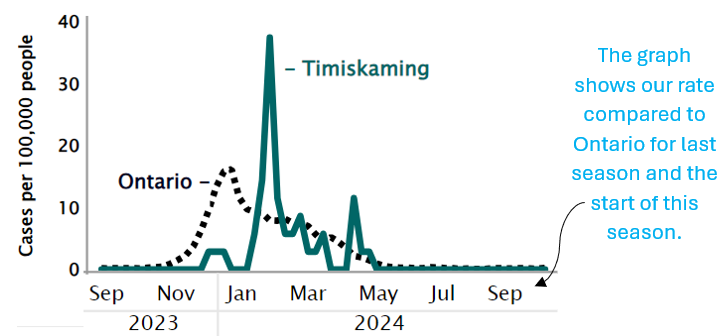
Positive Tests
The number of positive tests can provide insight into what viruses are circulating in our community. The number of positive tests differs from the number of people who tested positive because not everyone gets tested, and some get tested more than once. Definitions of various types of viruses can be found in the section on common respiratory viruses below.
So far this November, a high level of COVID-19, a low level of enter/rhinovirus, and a low level of seasonal human coronavirus have been detected in Timiskaming.3
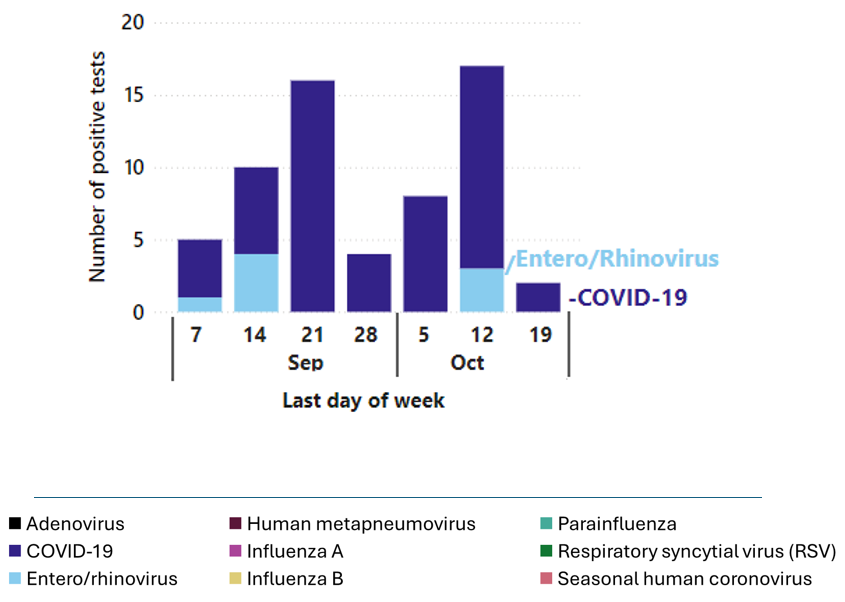
Hospitalizations
Hospitalization can provide insight into the severity of the respiratory viruses circulating in the community as well as the impact of respiratory viruses on the local health care system.
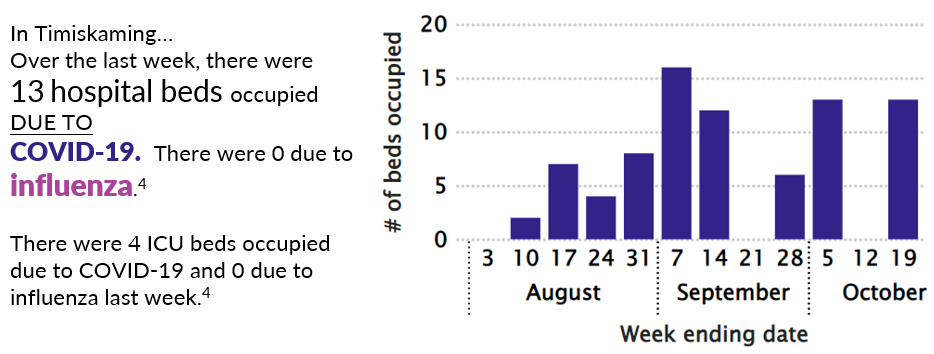
Local Institutional Outbreaks
Buildings or facilities where people live or stay
overnight and use shared spaces can put people at a higher risk of developing
or transmitting respiratory illnesses. These facilities, such as long-term care
homes, retirement homes, hospitals, or group homes, apply restrictions to help
limit the spread of illness. The following is a list of current outbreaks in
Timiskaming.
|
Institutional Name
|
Pathogen
|
Start date
|
| Extendicare Tri-Town |
COVID-19
|
Nov. 11, 2024
|
Teck Pioneer
|
Unknown
|
Oct. 30, 2024
|
Additional respiratory illness data for Ontario can be found on Public Health Ontario’s Respiratory Virus Tool.
Common respiratory viruses
The descriptions below are just a general overview. How sick someone gets can be different for each person. Some might only have mild symptoms, while others could get more severe symptoms, and sadly, in some cases, it can even lead to death.
Adenoviruses cause a range of illnesses, including respiratory and gastrointestinal infections. Symptoms may include fever, cough, and sore throat.
Coronaviruses (other than COVID-19) are a family of viruses causing respiratory infections. Some strains, like the common cold coronaviruses, result in mild symptoms. Others, such as those causing SARS and MERS, can lead to severe respiratory illnesses.
Enteroviruses and rhinoviruses commonly cause mild respiratory and gastrointestinal infections. Rhinoviruses are a frequent cause of the common cold, leading to symptoms like runny nose and congestion.
Human metapneumovirus (HMPV) is a respiratory virus that can cause infections, especially in children and older adults. Symptoms may include cough, fever, and difficulty breathing.
Influenza, commonly known as the flu, is caused by influenza viruses. The flu can result in a range of symptoms, including fever, cough, sore throat, body aches, fatigue, and more. Influenza can also spread by touching an infected object and then touching your mouth, nose, or eyes.
Parainfluenza viruses cause respiratory infections, such as croup and bronchiolitis, particularly in young children. Symptoms may include cough, fever, and a barking cough in the case of croup.
RSV stands for Respiratory Syncytial Virus. It is a common virus that can cause cold-like symptoms. RSV is a common virus affecting the respiratory tract, causing illnesses like bronchiolitis and pneumonia, especially in infants and young children.
Methods and sources
This data should be interpreted with caution for the most recent periods due to potential reporting and data cleaning delays. Previously reported data may change as a result.
1. The respiratory risk rating and trend were calculated using the number of local emergency department visits.
2. Integrated Public Health Information System, Timiskaming Health Unit
3. Ontario Agency for Health Protection and Promotion (Public Health Ontario). Ontario respiratory virus tool. Toronto, ON. Available at https://www.publichealthontario.ca/en/data-and-analysis/infectious-disease/id-query.
4. Ministry of Ontario, Capacity Planning and Analytics Division, Visual Analytics Hub – COVID Regional Hospital, Inpatient (19).
An intensive care unit (ICU) is a hospital department that provides intensive care to critically ill patients. Timiskaming’s ICUs are classified as level 2. Patients with specialized or more critical needs are transferred to a non-local, larger hospital with specialized level 3 ICUs. Patients transferred out of Timiskaming for care are not included in this total.


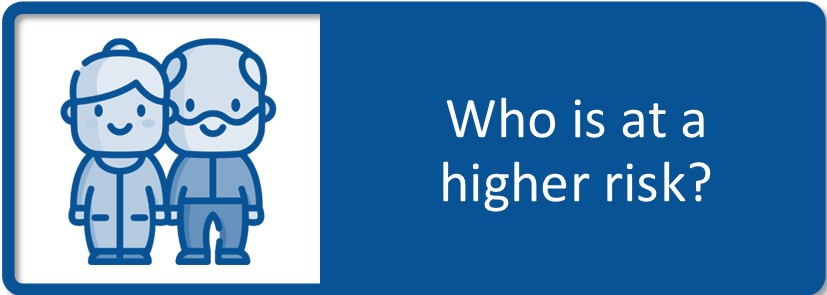

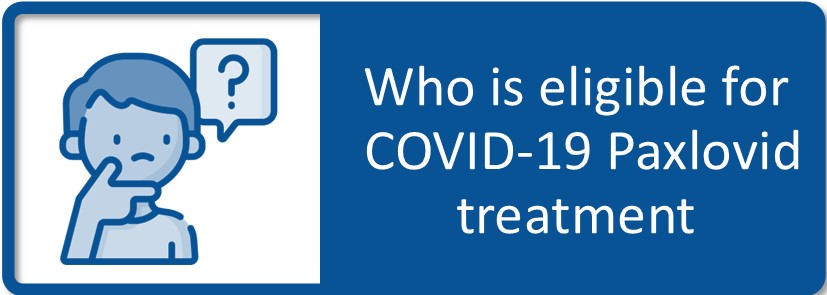
20241119/cb:nd